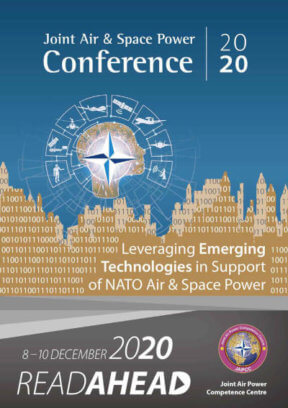Introduction
In 2020 the Joint Air & Space Power Conference will focus on how NATO leverages emerging technologies in support of Air & Space Power. Specifically, how do new capabilities operating in and through Space (NATO’s newest recognized operational domain) integrate into NATO Operations; both from a standpoint of additional capability contribution as well as potentially new challenges?
In the closing days of 2019 NATO recognised Space as an operational domain, referencing its importance in keeping the Alliance safe and in addressing security challenges, in line with international law. As NATO continues to integrate terrestrial and extra-terrestrial operations, what will be NATO’s role in ensuring freedom of movement in and through Space? Not only to ensure access to ever-increasingly important Space-based services to terrestrial operations but also to enable operations in Space in pursuit of freedom of movement for extra-terrestrial operations. Additionally, as NATO currently possesses no indigenousness Space capabilities, and has no current plans to begin procurement of any such capabilities, how will NATO achieve an accord amongst the member nations to ensure reliable and consistent delivery of Space-based products and services? Will the answers to these questions come from additional personnel, or are there emerging capabilities NATO can leverage to manage the myriad inputs (from Space) its member nations provide in a manner useable for NATO HQs and the forces they lead in operations? This panel will tackle these issues at a time when NATO is just starting to address some of these questions, and perhaps only realizing the complexity of the new domain it has entered.
Advances into Space and Space’s Recognized Relevancefor the Military
On October 4, 1957, the Soviet Union launched the first man-made object, Sputnik-1, into orbit around the earth. The Soviet launch forever changed the world and moved Space to centre stage in the on-going Cold War between Western Democracies and Eastern Bloc Communist nations. As the Space-Race continued, the world watched as the US and Soviet Union engaged in an international effort to outshine one another with ever-increasing advances into Space. The competition culminated, for a time, on July 20, 1969 with ‘Neil Armstrong’s and Buzz Aldrin’s first footprints in the lunar soil’.1 While the political chest-thumping of the Space Race dwindled, military applications of Space-related capabilities continued to develop. However, unlike the direct rivalry seen in the Space Race, many militaries with access to Space capabilities did not see ‘an entirely new mission, but rather, a new environment that can enhance traditional missions.’2
The ability of militaries to utilize Space-related capabilities was thrust onto the world stage during the Gulf War in 1991. Space ‘assets provided navigation, communications, intelligence, and imagery that were essential to increasing the combat effectiveness of the allied coalition.’3 In fact, ‘Space was so crucial to nearly every aspect of the operation that some military leaders called it the first true “space war”’.4 However, for all of the praise for contributions from Space in military operations, Space was seen as a utility for supporting those traditional missions on land, at sea, and in the air.
Within the burgeoning military Space community, particularly in the US, the belief that Space presented unique opportunities and challenges, and needed to be shepherded by professionals with expertise in Space Operations began to mature. This notion grew to the point the idea of a separate and independent Space Service began circulating, and gained traction in the US with the publication of the so-called Space Commission Report in 2001 which stated ‘the US has not yet taken the steps necessary to develop the needed capabilities and to maintain and ensure continuing superiority.’5 Many in the US Military saw this as a warning, if the current military structure did not address important issues related to Space then perhaps the organization should be changed.
Road to NATO’s Recognition of Space
While the status of Space, and its associated organizations and agencies, has slowly evolved over time, the advancement of technological capabilities resident in Space Systems has continued unabated. In the midst of these advancements, NATO (as an organization) has largely remained on the sidelines. Nations, both internal and external to the Alliance, have been the driving force behind the development and fielding of new Space capabilities. While NATO has procured agreements for its member nations to share data, products, and services (DPS) from Space, these agreements largely entail nations determining what DPS they will provide to NATO … with little to no requirements by the nations. Conversely, the nations (again both internal and external to the Alliance) have developed numerous sharing agreements regarding DPS, most often in the form bi-lateral arrangements, which may prove problematic in the event of a NATO-led military operation.
Supporting NATO’s Growth in Space
NATO’s recognition of Space as an Operational Domain does not include any planned or approved NATO procurement of Space-related capabilities, nor does it involve any increase in Space Personnel within the NATO Command Structure (NCS) yet; currently there are approximately 20 positions for Space personnel within the NCS. As NATO moves forward in its relationship with Space as an Operational Domain, it should do so in a manner commensurate with its (somewhat limited) capabilities and personnel strength. Rushing into bureaucratic decisions, which are often difficult to re-consider after the fact, without due consideration is fraught with peril.
NATO’s primary shift following its recognition of Space as an Operational Domain is to pursue policy objectives and to organize a Space Centre. The Space Centre, currently planned to be co-located with Headquarters Allied Air Command, is intended to serve as the coordination focal point for Space-related activities during NATO military operations. As the relatively small collection of dedicated Space Professionals within NATO strive to bring the Space Centre to fruition, new pursuits of technological development will remain with the Alliance nations. This places a premium on information regarding emerging technologies, and how the nations might employ them in support of NATO military operations.
Additional Articles
This section presents nine related articles which will introduce various ideas and issues related to the Operational Domain of Space, and the different challenges NATO faces therein. The ideas expressed in this article are meant to inspire some critical thinking to prepare those attending the 2020 Joint Air & Space Power Conference for the panel discussion on Space:
- In Space Situational Awareness Challenges, Professor Malgorzata Polkowska discusses efforts made by the Polish Space Agency (POLSA) in recent years. The paper details how POLSA’s activities guide the Polish Military in terms of Space related tasks and responsibilities. The paper also discusses POLSA on-going work with various European Agencies, to include the European Space Agency and the European Union Space Surveillance and Tracking Consortium.
- The next paper, Commercial Constellations and/or Mega-Constellations of Small Satellites in Low Earth Orbits is written by Lt Col Tim Vasen (DEU Army). This paper focuses on the continuously changing commercial Space Market with emphasis on smaller more technologically capable satellites. It explores the impacts to satellite communications and intelligence collection, with regards to the change in the commercial market, for the military planning and operations.
- Paul Szymanski’s What are Possible Conflict Termination Criteria that Define Winning the Next Space War appears next in the booklet. The paper provides a list of 15 possible Termination Criteria for consideration in a Space Conflict, briefly examining each of the proposed criteria and encouraging further discussion as to what the future will hold for conflict beyond the atmosphere.
- Space Connectivity for Air Combat 2040 is a collaborative work by Alain Frizon, Christian Calamarte, Christian Fournier, and Raphaël Ihamouine. This paper discusses the connectivity needs for operations spread across manned and unmanned platforms, flown by multiple services, and originating from different countries. The paper also touches upon technologies which can be considered to meet these needs.
- Stepping outside of NATO, Space Development and Changes on Traditional Power’s Balance delves into the role Space plays in South American power dynamics. Written by Victoria Valdivia, a Chilean Space Professional, this paper explores the role of Space in political balancing within and between South American Nations, on the continent, and with those nations’ interactions with global space powers.
- The contributions from outside of NATO continue with Cyber Threats to Space Systems, written by Gil Baram and Omree Wechsler of Tel Aviv University. This paper deals with Space from a perspective of maintaining an acceptable level of cyber defence of Space Systems. Detailing the cyber threats to the various segments of Space System, responses and mitigation actions, as well as NATO’s role.
- Assessing the Impact of Space Traffic Management on Military Space Operations, by Marc Becker, describes what Space Traffic Management might look like in an age of significantly increased constellations. The paper goes into how multiple governments and government agencies are attempting to address the issue, as well as the essential role of the military in the process.
- With NATO’s recent recognition of Space as an Operational Domain John J. Klein and Nickolas J. Boensch provide policy suggestions in Assured Access to Space through a Strengthened NATO Space Deterrence Strategy. Building upon deterrence theory for Space the paper examines ways NATO can implement a Space Deterrence Strategy and includes actions to be taken in the near-term.
- The final Space Panel paper deals with a topic new to many. In Applied-Field Magnetoplasmadynamic Thrusters, the importance of spacecraft propulsion is introduced along with an examination of new related technology. In this paper, Manuel Betancourt, Marcus Collier-Wright, Ryan O’Regan, David Hindley, Georg Herdrich, and Lamont Colucci discuss the operational impacts of new propulsion systems, as well as geopolitical background the need for NATO Cooperation going forward.












